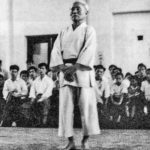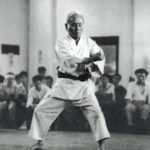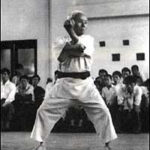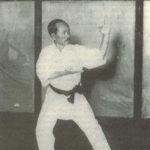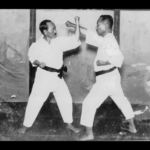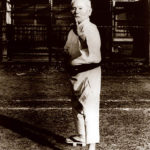Master Gichin Funakoshi is widely considered the primary "father" of modern karate due to his efforts to introduce the Okinawan art to mainland Japan, from where it spread to the rest of the world. Funakoshi Gichin was also the founder of what is now known as Shōtōkan Karate.
If there is one man who could be credited with popularising karate, it is Gichin Funakoshi. Funakoshi was born in 1868 in Shuri, then the capital city of the island of Okinawa. He started practicing karate while in primary school but didn't begin his mission of spreading it to the outside world until he was 53.
Funakoshi was born into a well-to-do family of scholars in Shuri, Okinawa, in 1868. His grandfather had been a tutor for the daughters of the village governor, and had been given a small estate and "privileged family" status in return. Gichin's father, however, was a heavy drinker, and squandered most of the family's wealth, so young Funakoshi grew up in a home that could provide very few luxuries.
As a teenager, Funakoshi was sickly and weak. Fortunately, when he finally started primary school, he happened to be in the same class as the son of Yasutsune Azato, a renowned karate master who had served as a military chief for the king of the Ryukyu Islands. Azato took Funakoshi on as his only student, teaching him late at night because of laws which forbid the teaching or practicing of karate.
It was from Azato and Azato's close friend Yasutsune Itosu that Funakoshi learned most of his martial arts. From childhood until he left for Tokyo in 1921, Funakoshi studied diligently from these two masters, learning not only shuri-te karate, but Chinese classical literature and poetry. He also spent a short time studying under Itosu's master, shuri-te founder Sokon Matsumura.
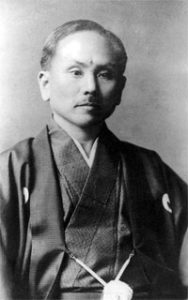
Funakoshi took a job as an assistant schoolteacher in 1888 at the age of 21, and also took a wife about the same time. He supported his wife, his parents and his grandparents on a salary of about three dollars a month. His wife, also karate adept, encouraged Funakoshi to continue practicing. In addition, she took a job working in the fields during the day and then wove fabrics at night to help make ends meet.
In 1901, karate practice was legalized in Okinawa, and its study became mandatory in middle schools. Securing permission from Azato and Itosu, Funakoshi announced that he would begin formally teaching karate. He was 33 years old.
There are many stories about Funakoshi's exploits as a youth. One thing is certain: he found more honor in avoiding a fight than in starting one, and he believed there was more courage in fleeing a confrontation than in defeating an enemy. He claimed to have only used his karate against another person one time, during World War II. A thief tried to attack him, but Funakoshi stepped out of the way and grabbed the man's testicles. He held the man in that position until a constable passed by. Although Funakoshi had not started the altercation, he later revealed that he always felt shame about that day because he had not avoided the confrontation.
It was that "true spirit of karate" that Funakoshi spent his entire life trying to achieve. Mas Oyama, who later created kyoku shinkai karate, once trained under Funakoshi, but quit because Funakoshi's karate was "too slow" and seemed more like a lesson in etiquette and discipline. But this was how Funakoshi wanted it. He taught that karate should not be used for self defense-even as a last resort-because once karate was used, the conflict became a matter of life or death, and somebody was going to get injured. Funakoshi always remembered the proverb Soken Matsumura taught him: "When two tigers fight, one is bound to be hurt. The other will be dead."
Funakoshi became so skillful at karate that he was chosen to teach it to the reigning King of Okinawa. Before Funakoshi left the island, he had already risen to the position of chairman of Shobukai, the martial arts association of Okinawa.
In May 1922, the Japan Education Ministry organized the first All Japan Athletic Exhibition of Ochanomizu in Tokyo. Wanting the event to be as comprehensive as possible, the ministry decided to include karate. As the province's leading practitioner, Funakoshi was the obvious choice. The Japanese budomen, tremendously impressed by karate, immediately set out to persuade Funakoshi to stay and teach the dynamic martial art to Japanese youth. He accepted the project with vigor, because he harbored a secret desire to see karate proliferate as kendo and judo had.
The arrival of Gichin Funakoshi was inauspicious, to say the least, and no one seriously expected anything to come of his visit to Japan. At 51, the mild-mannered high school teacher from Naha was already well past his prime. But how were they to know that Gichin Funakoshi was destined to become the Father of Japanese Karate and would set in motion the forces of a little-known martial art which would one day sweep the world?
Funakoshi karate was well received by the Japanese, and judo founder Jigoro Kano asked for private lessons on basic karate kata (forms). Funakoshi taught Kano for several months and then arranged to return to Okinawa. Before he could leave, however, Hoan Kosugi, a popular artist of that time, asked Funakoshi to teach both him and his fellow artists karate, because there was no one else in the area who could. It was then Funakoshi realized that, if he were to spread karate throughout Japan, Tokyo was the place to do it.
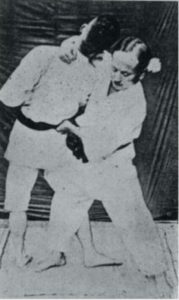 Judo founder Jigoro Kano was so impressed with Gichin Funakoshi's karate that he asked for, and received, private karate lessons from Funakoshi for several months. Taking up residence at a dormitory for Okinawan students at Keio University, Funakoshi began teaching karate in the dorm's lecture hall.
Judo founder Jigoro Kano was so impressed with Gichin Funakoshi's karate that he asked for, and received, private karate lessons from Funakoshi for several months. Taking up residence at a dormitory for Okinawan students at Keio University, Funakoshi began teaching karate in the dorm's lecture hall.
Funakoshi became a subject of some controversy only a few years after relocating to Tokyo. For centuries, karate had been written two different ways in Japanese. One way used the characters for "Chinese hands," and the other used the characters for "empty hands." Although both were pronounced "karate," they were written differently. Funakoshi agreed with the obvious historical allusion in the "Chinese hands" characters, but he felt that the use of "empty hands" not only emphasized the art of self-defense without weapons, but also characterized the sense of emptying one's heart and mind of earthly desires and vanity. When he wrote his first book, Ryukyu Kempo: Karate, in 1922, he used the "empty hands" characters exclusively. Funakoshi is credited with standardizing the writing of karate, a feat which, though angering several martial arts masters at the time, met with eventual universal approval.
In 1923, a massive earthquake shook Japan, and Tokyo was razed in the ensuing fire. Although the dormitory Funakoshi called home and still taught out of was spared, many of his students died or disappeared. For a short time he suspended his instruction and spent the next several months assisting in the massive cleanup.
Funakoshi's next major task was the creation of an all-new dojo (training hall). Because he had a difficult time raising funds, the building was not started until 1935. A year later, the world's first freestanding karate dojo was completed. Funakoshi named the school "shotokan" (the house of Shoto) after the pen name he used when writing poetry. When he stepped through the doors for the first time, he was almost 70 years old.
As he became increasingly busy with his dojo, Funakoshi began handing over his teaching assignments at the various universities to his students. He still conducted demonstrations, however, including regular performances before Emperor Hirohito, who invited him to the Imperial Palace on an annual basis.
The United States declared war on Japan on December 8, 1941, and times grew hard in Japan. Funakoshi's third son, Gigo, who was supposed to inherit his father's school, died of tuberculosis in 1945. A few months later, Funakoshi's dojo was destroyed by Allied bombers. In that same year, the battle for Okinawa began in earnest, and many people fled to the island of Kyushu, including Funakoshi's wife, who had remained in Shuri during his residence in Tokyo. The couple were reunited at a refugee camp on Kyushu, and Funakoshi stayed with his wife until her death in 1947. He then boarded a train for Tokyo to start all over again.
More than just the buildings had been demolished in Japan during the war; national spirit had been eroded as well. The occupying forces disallowed martial arts instruction. Fortunately, because of Funakoshi's association with the Ministry of Education, karate was classified as physical education, not a martial art. He therefore began teaching again, and within a few years was drawing martial artists from other disciplines, all of whom were longing for a place to practice. Included among these new recruits were American servicemen, who were amazed at this form of exercise. For every GI who returned to the United States with a karate tale, Funakoshi received two more letters from Americans who wished to become students.
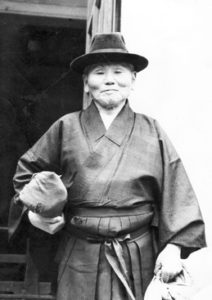
Funakoshi, approaching his mid-80s, found a new task. He had spread karate throughout Japan, now it was time to spread it throughout the world. In 1953, after several requests from Americans for qualified karate instructors, he began sending some of his finest students to the United States to begin teaching martial arts. These men, who included Masatoshi Nakayama, Hidetaka Nishiyama and Tsutomu Ohshima, were America's karate pioneers. Funakoshi eventually organized his students and their schools into the Japan Karate Association in 1955, one of the first international martial arts associations.
Two years later, at age 89, Funakoshi died in his sleep, leaving behind a legacy so huge that its shadow stretched from the shores of tiny Okinawa across the Pacific Ocean to the United States. Funakoshi took little credit for karate's immense popularity, but few denied that he had almost single-handedly brought the art to Japan and subsequently sent it overseas.
Funakoshi Teaching
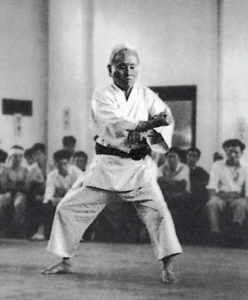 Funakoshi concentrated almost entirely on teaching kata. He brought 15 kata compiled from various styles, and developed some himself. Although he taught a little kumite, his approach to karate was based on the following precept: "Once you have completely mastered kata, then you can adapt it to kumite." The closest thing to karate in Japan when Funakoshi arrived was the atemi (technique of striking the vital parts of the body).
Funakoshi concentrated almost entirely on teaching kata. He brought 15 kata compiled from various styles, and developed some himself. Although he taught a little kumite, his approach to karate was based on the following precept: "Once you have completely mastered kata, then you can adapt it to kumite." The closest thing to karate in Japan when Funakoshi arrived was the atemi (technique of striking the vital parts of the body).
Funakoshi also stressed the importance of toughening each part of the body until it was as hard as iron. He constantly beat himself with an oak staff to drive home his point to his students! A makiwara (straw-padded pole) was used to toughen the hands and feet.
Even in his 50s and 60s Funakoshi was agile and unusually strong, especially in defense. Funakoshi's defense was very difficult to penetrate during training, no matter how hard his students tried.
Perhaps the most important work Funakoshi accomplished was during the 30's when he systematized karate kata and techniques, incorporating a code of ethics and discipline found in the other Japanese martial arts. This codification forged the bonds that would one day transform karate into a mental and physical discipline which would rival judo in "finding the way." He published three books on the subject-the second and the most important one of which, Karate-Do Instructions, was published in 1939. Aided by his son Yoshitaka, Funakoshi continued teaching karate throughout the rest of the decade at the Mejiro dojo as well as at the college clubs he had organized. When the war broke out, the number of students gradually decreased because of the draft.
Most of Funakoshi's former students remember him as a mild, gentle and friendly person. The Okinawan master always shook hands and put his arm around them when they met. He wasn't bossy, but when he was teaching karate, he was very strict.
He didn't drink, smoke, gamble or play around with women. He was the kind of man who never made enemies. Outside of karate, his two main interests were calligraphy and composing Chinese poems. He was convinced that living a good, clean life created a character best suited for the study of karate. He educated his students by trying to get them to fulfil their own potential.
Before he brought karate to Japan from Okinawa, it was just a local system in Okinawa. Upon bringing karate to Japan and seeing Japan's traditional martial arts, such as judo and kendo, Master Funakoshi patterned karate after these arts to a large degree and made karate popular. He had the technical and philosophical ability to do this and got people to accept his ideas about karate rather easily. This was one of his biggest contributions to the martial arts. That's why it is often said that Master Funakoshi was a great philosopher and a great technician. On karate's spiritual side, too many people look on the surface of karate and only see violent techniques: kicking, punching and striking. They see karate as something that's only very dangerous. But Master Funakoshi combined karate techniques with traditional budo (the martial way) to put the essence of budo into karate-a real way of the martial arts. That's why Master Funakoshi's students did not have any violent ideas. He taught that karate is defensive, never offensive. When Master Funakoshi studied in Okinawa, you couldn't publicly practice karate. It wasn't for everybody and was secret. Karate practitioners were like a secret society. But Master Funakoshi opened karate to the public and proved that its techniques are effective. And yet, Master Funakoshi not only stressed the technical aspects of karate, he emphasized that karate has a philosophical background. To him, karate had a philosophical essence that carried over into other parts of students' lives. In other words, karate was a way of life: karate-do. Otherwise, you only have karate-jutsu, which is just the art of fighting. Master Funakoshi made this distinction.
When you first met him, he looked very old. Nobody would guess that he was a real grandmaster. That's how humble he was. He always felt he needed more study, and was a great example of a genuine martial artist. Some masters, once they reach a certain point, like to show off. "I'm a fifth-degree black belt; I'm the strongest man in the world," they spout. Such behavior had nothing to do with Master Funakoshi's philosophy. He felt no need to show off. Once he put on a gi (karate uniform), however, and went into the dojo, he was different- right away. He still didn't show off, but he changed. When he stood in the dojo, he looked as though one of his movements could destroy anything. That's how good his techniques were. Then, when he finished training, he again became very humble. Master Funakoshi always said that the martial artist's etiquette was very important, and that etiquette was the sign of the true martial artist. That's why Master Funakoshi didn't look like a so-called "real" grand- master. He didn't show that kind of thing except in the dojo.
Master Funakoshi was very wise and had a broad mind. He felt that karate should be open to everybody; he wanted everybody to know the art. If you have some nice medicine, he felt you should share it with everybody. That's why he agreed to form an association, and that's why he created the JKA. He never said anything about any one particular style. For instance, some had goju style, while others had wado style. But he never taught the need for styles.
Funakoshi always believed kata was the secret to becoming skilled in karate. He made students practice the pinan and naihanchi forms for at least three years before he allowed them to progress to the more advanced kata. The repetitious training paid off, though, because his students developed the most precise, exact karate taught anywhere.
Funakoshi was a man of Tao. He placed no emphasis on competitions, record breaking or championships. Instead, he emphasised self-perfection. He believed in the common decency and respect that one human being owed another. He was the master of masters.
As karate legends go, Gichin Funakoshi's life was not terribly exciting. He never challenged anyone to a sword duel, never attempted to dismantle a bull's horn, never had a presumptuous nickname and, in fact, never left the islands of Japan. He was a poet, and a schoolteacher, and the closest he ever came to seeing battle was when he mediated a dispute between two neighboring villages.
Yet Funakoshi is one of the most honored, cherished and memorable martial artists in history. His innovations left indelible marks on the art form we know today as karate. Not only was shotokan karate, the style he founded, influenced by Funakoshi, but dozens of other styles as well.
Funakoshi died in 1957 at the age of 88, after humbly making a tremendous contribution to the art of karate.

